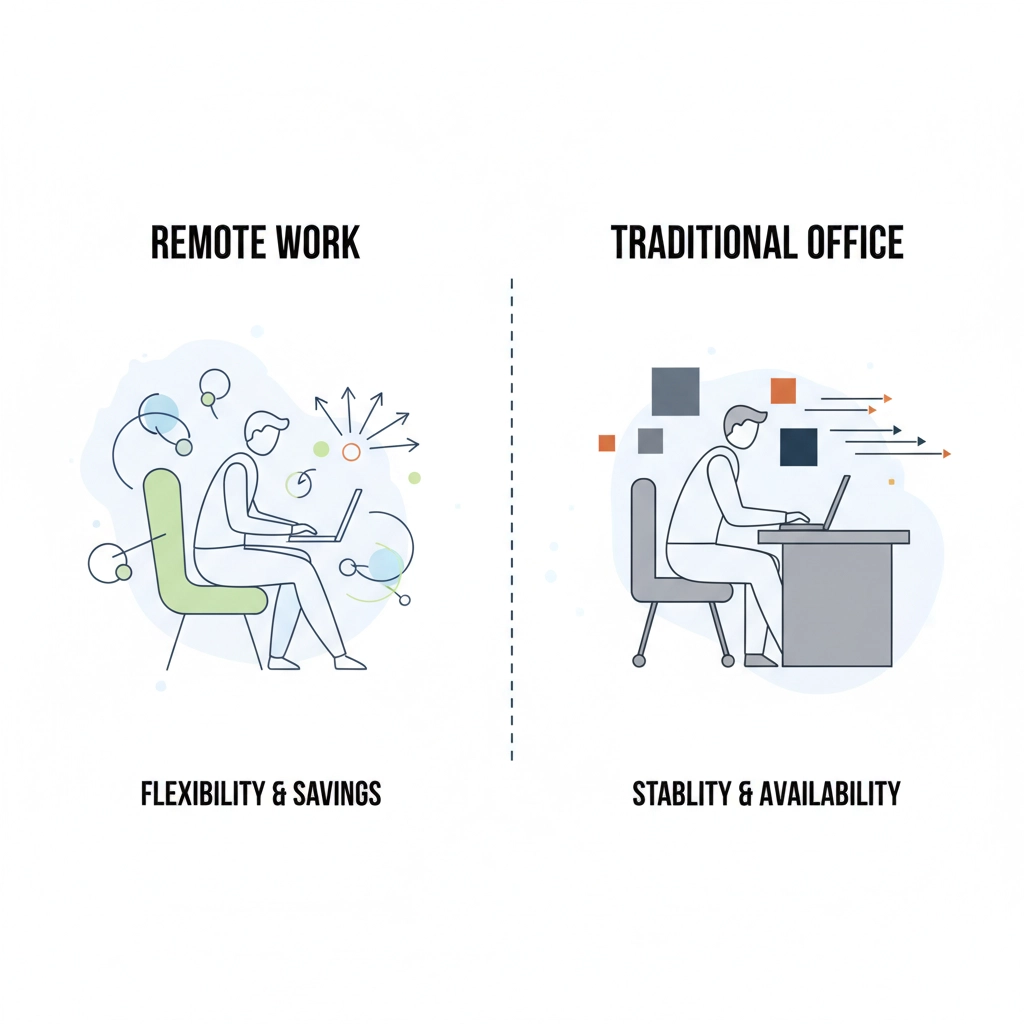For growing SMBs, choosing between a virtual IT director and a full-time IT hire ranks among the most critical technology decisions you'll make. This choice impacts your budget, operational efficiency, and strategic capability for years ahead.
The stakes are high. Hire full-time too early, and you're spending £120,000+ annually on overhead that could fund actual technology improvements. Wait too long for strategic IT leadership, and you risk security breaches, compliance failures, and missed growth opportunities.
This guide breaks down both options, helping you make the right choice for your business size, budget, and operational needs.
Understanding Virtual IT Directors
Virtual IT directors (also called vCIOs) provide executive-level IT strategy and oversight on a part-time or contract basis. They work remotely or visit your office periodically, focusing on high-level planning rather than day-to-day operations.
Think of them as your strategic IT brain without the full-time salary commitment.
Virtual IT Director Advantages
Cost Effectiveness Wins Big
Virtual IT directors typically cost 60-75% less than full-time hires. Instead of £120,000-150,000 annually for salary, benefits, and overhead, you might pay £30,000-50,000 for strategic oversight. That savings can fund actual technology improvements, software licenses, or security tools that directly impact your business.
Access to Broader Expertise
Full-time directors often specialize in specific areas. Virtual directors work across multiple clients and industries, exposing them to diverse challenges and solutions. Your virtual director might have experience with manufacturing compliance, retail PCI requirements, and professional services backup strategies – knowledge that benefits your specific situation.
Scalability Matches Your Growth
Small businesses don't grow linearly. You might need intensive IT strategy during expansion phases, then lighter oversight during stable periods. Virtual arrangements let you scale services up or down without restructuring employment contracts or managing redundancies.
Strategic Focus Without Distractions
Virtual directors aren't pulled into daily firefighting. They focus on strategy, planning, and vendor management rather than password resets or printer troubleshooting. This separation ensures consistent attention to long-term technology direction.

Virtual IT Director Limitations
Limited Crisis Response
When your server crashes at 2 AM, virtual directors aren't immediately available. You need existing support arrangements – internal staff or managed service providers – to handle urgent operational issues.
Slower Institutional Knowledge Development
Part-time engagement means slower understanding of your specific systems, processes, and organizational culture. They need time to fully grasp your business nuances and technical environment.
Requires Existing IT Foundation
Virtual directors assume you have basic operational support in place. Without existing IT staff or managed services, gaps emerge in daily system management and user support.
Full-Time IT Directors: Dedicated Leadership
Full-time IT directors serve as your dedicated technology leader, managing both strategic planning and operational oversight. They're embedded in your organization, available for immediate response, and focused entirely on your business needs.
Full-Time IT Director Advantages
Immediate Availability and Response
System outages don't wait for scheduled meetings. Full-time directors can address critical issues within minutes, minimizing downtime and business impact. This responsiveness proves invaluable for businesses with mission-critical systems or tight operational schedules.
Deep Institutional Knowledge
Daily immersion in your systems creates comprehensive understanding of configurations, decisions history, and organizational workflows. This knowledge enables faster problem diagnosis and more effective solution implementation.
Direct Team Management
If you employ multiple IT staff members, full-time directors provide consistent oversight, performance management, and project coordination. They handle hiring decisions, skill development, and workload distribution across your internal team.
Cultural Integration and Alignment
Full-time employees invest in long-term organizational success. They understand company culture, build relationships across departments, and align IT decisions with business objectives more naturally than external consultants.
Full-Time IT Director Limitations
Significant Cost Investment
Beyond base salaries of £80,000-120,000, add benefits, office space, equipment, and training costs. Total annual investment often exceeds £150,000, representing substantial overhead for businesses under £10 million revenue.
Limited Strategic Time
Most full-time IT directors spend 70-80% of their time on operational tasks – managing staff, handling escalations, and addressing daily issues. Strategic planning often gets squeezed into remaining hours, limiting long-term focus.
Single Point of Dependency
Organizations become vulnerable when critical knowledge concentrates in one person. If your IT director leaves unexpectedly, continuity suffers while you search for replacements and transfer institutional knowledge.
Career Development Challenges
Talented IT directors in smaller organizations may lack advancement opportunities, leading to turnover as they seek growth elsewhere. This creates ongoing recruitment and training costs.

Decision Framework: When to Choose Each Option
Choose Virtual IT Directors When:
Your annual revenue falls between £2-15 million, and budget efficiency drives most decisions. You need strategic IT leadership but don't require constant on-site presence. Your existing IT support – whether internal staff or managed service providers – handles day-to-day operations effectively.
You want flexibility to adjust IT leadership investment based on business cycles. Virtual arrangements let you scale services during growth phases or reduce costs during slower periods without employment complications.
Your technology needs span multiple disciplines – cybersecurity, cloud strategy, compliance, vendor management – that would be difficult to find in a single full-time hire.
Choose Full-Time IT Directors When:
You operate mission-critical systems that cannot tolerate extended downtime. Manufacturing control systems, healthcare patient management, or 24/7 service operations require immediate response capability that virtual directors cannot provide.
You manage teams of five or more IT staff members. The overhead of daily team management, performance reviews, and project coordination justifies dedicated leadership investment.
Your business has complex, specialized systems requiring deep daily knowledge. Custom integrations, legacy systems, or industry-specific applications benefit from dedicated attention and institutional memory.
Your IT budget comfortably exceeds £200,000 annually. At this level, director salaries represent reasonable investment proportions rather than budget strain.
Consider Hybrid Approaches
Start with virtual IT director services if you're uncertain about your needs. Lower commitment and costs make it easier to assess effectiveness before committing to full-time positions. You can always transition to internal leadership later if requirements change.
Alternatively, combine virtual strategic oversight with internal operational staff. This approach provides strategic direction while maintaining hands-on support for daily needs.

Making the Right Choice for Your Business
Consider your current situation honestly. If you're spending significant time managing IT issues, struggling with vendor relationships, or lacking strategic technology direction, leadership investment makes sense. The question becomes whether virtual or full-time arrangements serve your needs better.
Budget constraints often drive initial decisions, but consider long-term implications. Saving money short-term while risking security breaches or compliance failures costs more than strategic investment in proper IT leadership.
Evaluate your existing IT foundation. Strong managed service relationships or capable internal staff complement virtual directors well. Weak operational support requires full-time attention or additional service investments.
How Bailey & Associates Can Help
At Bailey & Associates, we specialize in virtual IT director services for growing SMBs. Our approach combines strategic oversight with practical implementation support, helping you achieve IT leadership benefits without full-time overhead.
We work with businesses across industries, bringing diverse experience to your specific challenges. Whether you need cybersecurity strategy, compliance guidance, vendor management, or technology planning, our virtual IT directors provide executive-level expertise at flexible service levels.
Our virtual IT director services include quarterly strategic reviews, monthly progress assessments, vendor evaluation and management, security posture analysis, and compliance planning support. We scale services based on your business needs and growth phases.
Ready to explore whether virtual IT director services make sense for your business? Contact us for a consultation where we'll assess your current IT situation, discuss strategic priorities, and outline how virtual IT leadership could support your growth objectives.
The choice between virtual and full-time IT directors shapes your technology trajectory for years. Make it based on clear understanding of your needs, budget realities, and growth plans rather than default assumptions about what businesses "should" do.
